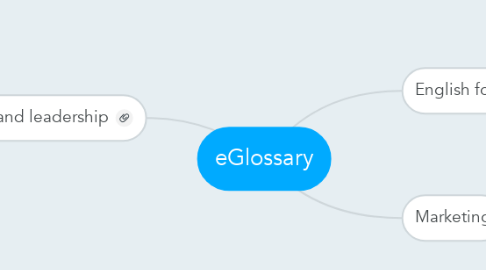eGlossary
作者:Nasser AlBlooshi

1. English for Business
1.1. Unit One
1.1.1. Innovation: New Idea; creative idea
1.1.2. Motivation: Providing with a reason to act in a certain way
1.1.3. integrating: to bring together
1.1.4. Debt: To owe someone
1.1.5. Subordinates: Someone lower in statues
1.1.6. Analyzing: To collect data
1.2. Unit Two
1.2.1. Achievement: to achieve a goal
1.2.2. Ambitious: having or showing a strong desire and determination to succeed
1.2.3. Bonuses: a reward for good performance
1.2.4. Corporate Culture: Different cultures
1.2.5. Creative: new ideas
1.2.6. Esteem: Moral
1.2.7. Hierarchy: A triangle of information
1.2.8. Incentive: a thing that motivates or encourages one to do something
1.2.9. Pessimistic: a negative opinion
1.2.10. Optimistic: A positive opinion
1.2.11. Remuneration: money paid for work or a service.
1.2.12. Self-actualization: the realization or fulfillment of one's talents and potentialities, esp. considered as a drive or need present in everyone.
1.3. Unit Three
1.3.1. Autonomous: indépendant (free)
1.3.2. Collaborating: work jointly on an activity
1.3.3. Delegation: assign authority or give power
1.3.4. downsizing: make (a company or organization) smaller by eliminating staff positions.
1.3.5. economy downturn: loss of profit
1.3.6. foreign subsidiary: Another Branch.
1.3.7. Full Capacity: Working at most
1.3.8. Functional structure: a job
1.3.9. high commission: extra money
1.3.10. Market Segments: Parts of the markets
1.3.11. matrix management: ways to organize the company
1.3.12. Outsourcing: obtain (goods or a service) from an outside or foreign supplier.
1.3.13. Wikinomics: quick economics
1.3.14. recessions: going downhill
2. Marketing
2.1. Marketing: the action or business of promoting and selling products or services, including market research and advertising.
2.2. Marketing Environment: is made of the actors and forces outside marketing that affect marketing management’s ability to develop and maintain successful relationships with its target customers
2.3. Microenvironment: A microenvironment consists of the actors close to the company that affect its ability to serve its customers, the company, suppliers, marketing intermediaries, customer markets, competitors, and publics.
2.4. political environment: is the laws, government agencies, and pressure groups that influence and limit various organisations and individuals in a given society.
2.5. Marketing Research: The systematic design, collection, analysis, and reporting of data relevant to a specific marketing situation
2.6. Market targeting: is the process of evaluating each market segment’s attractiveness and selecting one or more segments to enter.
2.7. Differentiation: involves actually differentiating the market offering to create superior customer value.
2.8. Positioning: consists of arranging for a market offering to occupy a clear, distinctive, and desirable place relative to competing products in the minds of target consumers.
2.9. Measurable: the size, purchasing power and profiles of the segments can be measured.
2.10. Accessible: the segments can be effectively reached and served.
2.11. Substantial: the marker segments are large or profitable enough to serve.
2.12. Differentiable: the segments are conceptually distinguishable and respond differently to different marketing mix elements and programmer.
2.13. Actionable: Effective programs can be designed for attracting and serving the segments
3. Management and leadership
3.1. manager: a person responsible for controlling or administering all or part of a company or similar organization
3.2. management: involves coordinating and overseeing the work activities of others so that their activities are completed efficiently and effectively.
3.3. efficiency: efficient
3.4. effectiveness: the degree to which something is successful in producing a desired result; success
3.5. organization: an organized body of people with a particular purpose, esp. a business, society, association
3.6. leader: the person who leads or commands a group, organization, or country
3.7. leadership: the action of leading a group of people or an organization
3.8. situational leadership: a leadership style that has been developed by Kenneth Blanchard and Paul Hersey, it refers to when the leader or manager of an organization must adjust his style to fit the development level of the followers he is trying to influence.
3.9. credibility: the quality of being trusted and believed in
3.10. empowerment: give (someone) the authority or power to do something
3.11. socialization: mix socially with others
3.12. ethics: moral principles that govern a person's or group's behavior
3.13. organizational culture: is the behavior of humans who are part of an organization and the meanings that the people react to their actions
3.14. equity: the quality of being fair and impartial: equity of treatment.
3.15. Telecommuting: work from home, making use of the Internet, e-mail, and the telephone.

